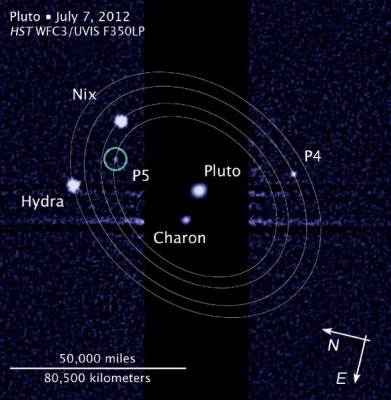
Despite being downgraded to dwarf planet status in 2006, Pluto is still a fairly large celestial body in our solar system and it does have at least five moons. The largest being Charon, which was discovered in 1978, Nix and Hydra, discovered in 2005, and the provisionally named S/2011 (134340) 1, discovered in 2011, and S/2012 (134340) 1, discovered in 2012.
The last two of these moons is in great need of “real” names and astronomers at SETI are now hosting a poll to provide them with better names. They have sorted the names down to a few now available for voting:
- Acheron — One of the five rivers of the underworld, symbolizing pain.
- Alecto — One of the furies, hideous snake-haired monsters who were servants of Hades. It was the job of Alecto to punish mortals for their crimes of anger.
- Cerberus — The three-headed dog who guards the gates to the underworld, preventing the dead from escaping.
- Erebus — A primordial god and the personification of darkness. With Nyx, he fathered many children including Hypnos and Styx.
- Eurydice — The wife of Orpheus, for whom he entered the underworld. During their journey home, Orpheus violated his agreement with Persephone not to look back, and Eurydice was lost forever.
- Hercules — The heroic demigod who slew the Hydra, entered the underworld and who also carried Cerberus back, one of very few who ever returned from the underworld.
- Hypnos — A son of Nyx and the personification of sleep.
- Lethe — One of the five rivers of the underworld, symbolizing oblivion, which flows through the cave of Hypnos and merges with the river Styx.
- Obol — The coin paid to Charon in order to obtain passage across the river Styx.
- Orpheus — A gifted musician who entered the underworld to retrieve his wife Eurydice and charmed Hades and Persephone with his music to become the only mortal ever to return from the underworld.
- Persephone — A goddess kidnapped by Hades to become the queen of the underworld who symbolizes vegetation and rebirth.
- Styx — The river that separates Earth from the underworld. The name also refers to the goddess of the river Styx, daughter of Nyx and Erebus.
That all these names have one thing in common is probably apparent, as they all derive from Greek mythology. The reason for this is the name of Pluto itself. The name of the planetoid gives provides the framework for which its moons should relate to.

The name “Pluto” was actually proposed by eleven-year-old schoolgirl Venetia Burney, from Oxford, England. She was interested in classical mythology as well as astronomy. Since Pluto is the name of the god of the underworld, it was suggested by Venetia and deemed appropriate for such a presumably dark and cold world, as planet Pluto.
She suggested the name to her grandfather Falconer Madan, who was the former librarian at the University of Oxford’s Bodleian Library. And He passed the name to Professor Herbert Hall Turner, who then cabled it to colleagues in the United States.
It is typical that moons are associated with the mythological god for which their planets are named. For instance, the Martian moons Phobos and Deimos are named for the sons of Ares, the God of War.
Pluto was discovered with firm evidence in 1930 (although speculated about earlier), when after nearly a year of searching, Clyde Tombaugh discovered a possible moving object on photographic plates taken on January 23 and January 29 of that year.
To vote head to this address:
Here you can also find a naming guide by SETI:
http://motherboard.vice.com/blog/you-can-help-name-plutos-newly-discovered-moons
And as a bonus on the topic on Pluto we recommend these two talks with astronomer Niel deGrasse Tyson, Niel deGrasse Tyson: The Pluto Files and Authors@Google: Neil deGrasse Tyson.











![OpenAI. (2025). ChatGPT [Large language model]. https://chatgpt.com](https://www.illustratedcuriosity.com/files/media/55136/b1b0b614-5b72-486c-901d-ff244549d67a-350x260.webp)
![OpenAI. (2025). ChatGPT [Large language model]. https://chatgpt.com](https://www.illustratedcuriosity.com/files/media/55124/79bc18fa-f616-4951-856f-cc724ad5d497-350x260.webp)
![OpenAI. (2025). ChatGPT [Large language model]. https://chatgpt.com](https://www.illustratedcuriosity.com/files/media/55099/2638a982-b4de-4913-8a1c-1479df352bf3-350x260.webp)








